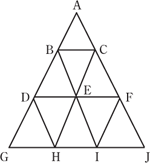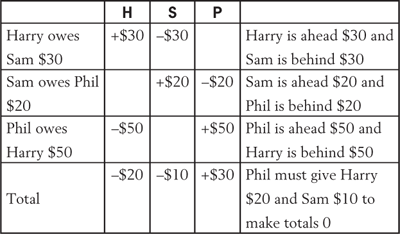World's 200 Hardest Brain Teasers (8 page)
Read World's 200 Hardest Brain Teasers Online
Authors: Dr. Gary R. Gruber

A powerful strategy in geometry is to draw extra lines to get more information from the problem. You may not remember this, but when you first took geometry, one of the first proofs that the teacher probably showed was “if two sides of a triangle are equal, then the base angles are equal.” The teacher drew a perpendicular line to start the proof—unfortunately the teacher probably did not tell you that the reason she did this was because when you draw something you get more information and are able to start solving the problem. A natural phenomenon! So in this problem, draw a line to make a rectangle in the figure and you will find that you will have a 3-4-5 triangle.
x
= 5.
37. (c) 40 percent
Translate words to math.
Percent
can be translated to 1/100,
of
to X,
what
to x,
is
to =.
A = [250/100](B).
x
/100 (A) = B.
Substitute:
x
/100[(250/100)]B = B.
Cancel B:
x
/100[250/100] = 1. 250
x
/10000 = 1 so
x
= 10,000/250 = 40.
38. The average rate is less than the average of the rates.
Average rate = 2AB/(A + B).
Average of the rates = (A + B)/2.
Detailed solution:
From the formula of Rate x Time = Distance, calling the time for the car to go uphill,
t,
and the time for the car to go downhill,
T,
with
D
being the distance downhill and uphill,
(1) A x
t
=
D
and
(2) B x
T
= D.
Now, Average rate = Total distance/Total time.
So,
(3) Average rate = 2
D/( t
+
T).
From (1) we have
(4)
t
= D/A
and from (2) we have
(5)
T
= D/B
Substituting from (4) and (5) in (3), we get
(6) Average rate = 2D/(D/A + D/B)
This becomes
(7) Average rate = 2AB/(A + B)
But the average of the rates is just (A + B)/2. So we ask, is
2AB/(A+B) greater, equal to, or less than (A+B)/2?
So we compare
2AB/(A+B) with (A+B)/2.
Put 2AB/(A+B) under a Column A and (A+B)/2 under a Column B and let’s compare the Columns:

Now multiply both columns by 2 and then by (A + B). We get

This becomes

Now subtract 4AB from both columns.
We get:

But A x A - 2AB + B x B = (A - B)(A - B) so we get:

Since we are told that A and B are
different
rates, A - B cannot be 0, and so (A - B)(A - B) is always greater than 0 whether A is greater than B or less than B. So Column B is greater than Column A and the original quantity in Column B, the average of the rates, is greater than the original quantity in Column A, the average rate.
39. e, a, c, b, d
40. (e) 13
Almost everyone who tries this problem gets it wrong! To get the right answer, you have to visualize something that is not straightforward.
When this problem first appeared in the
Washington Post
and other newspapers throughout the country in 1995, forty percent of people answered (a) 9 because they just added the small triangles in the figure, ABC, BDE, BEC, etc. Twenty-five percent of people answered (b)10 because they added the small triangles in the figure and also added the big triangle AGJ. Eight percent of people answered (c) 11 because they added the small triangles, the big triangle AGJ, and triangle ADF. Sixteen percent chose (f) none of the above, many of whom merely guessed at an answer without really working it out. Seven percent of people chose the correct answer, (e) 13, because they added the small triangles, the big triangle, triangle ADF, and the triangles BGI and CHJ.
Note: Four percent of people chose (d) 12—they were almost correct. They added the small triangles, the big triangle, and triangle ADF but then only added the triangle BGI and not also CHJ.

41. When the bird flies, it pushes down on the air, which pushes down on the scale. The scale reads the same.
42. (e) cannot be determined because this is an ambiguous question
How can you overtake the person who is last?
43. (b) 202/962 is greater. Add 208/962 to both quantities and compare.
44. (e) termite : house
Create a sentence expressing a specific relationship between the capitalized words.
MOTH is a living thing that destroys CLOTHING, as termite is a living thing that destroys a house.
45. (a) No good person lives to an old age and (d) All bad people do not die young. “Only the good die young” means that those who are not good do not die young and no good person does not die young. Choice (c) Only bad people do not die young would have been correct if all people were either good or bad. Some may be neither.
46. (e) Phil could give Harry $20 and could give Sam $10.
This could really give you a headache if you don’t represent what’s given in a table.

47. (d) I and II only
If nobody loves nobody, then it is like saying nobody loves zero people. So they must love more than zero people. Then somebody loves somebody and everybody loves somebody.
48. (e) 2 x 6 x 36
When you have to choose something different from the rest of other choices, look for either something all the other choices have that the correct one doesn’t, or something that the correct choice has that the other choices don’t have. So don’t multiply: Notice that all choices are divisible by 5 except choice (e), 2 x 6 x 36. Also, (e) 2 x 6 x 36 is the only choice that is divisible by 9.
49. (c) 37 percent
The equivalent single discount is less than the sum of the discounts. Start with $100. A 30 percent discount gives you a $70 price. A 10 percent discount on $70 gives you a price of $63. $100 - $63 = $37 discount, which is equivalent to a 37 percent discount on $100.
50. 25°
To find the solution, label all the angles with angle BEC =
x.
Let AEB =
AEB =
y, BEC =
BEC =
x
, and CED = z.
CED = z.